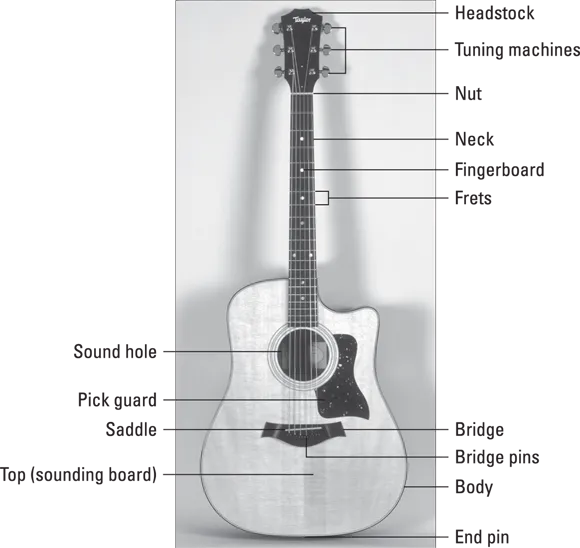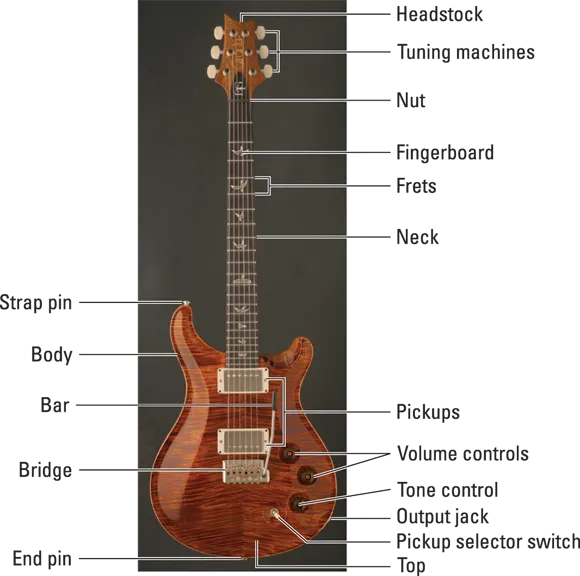
- English
- ePUB (mobile friendly)
- Available on iOS & Android
Guitar For Dummies
About this book
The bestselling guide now updated with video demonstrations and audio tracks online
The guitar is one of the most versatile instruments in the world, which is why it's so appealing to musicians. Guitar For Dummies, 4th Edition gives you everything a beginning or intermediate acoustic or electric guitarist needs: from buying a guitar to tuning it, playing it, and caring for it. Fully revised and updated, with online video and audio clips that help you learn and play along, you'll explore everything from simple chords and melodies to more challenging exercises that are designed to satisfy players of all levels. Additionally, new players can dive into the basics of guitar and accessory selection. Whether you prefer the cool sounds of the acoustic or the edgier tones of the electric, your guitar will get a lot of use as you play your way through the lessons presented in this integral book. But your journey doesn't stop at the last page! With an updated multimedia component, you have access to more than 80 online videos and 35 audio tracks that help build your talent.
- Play along with online videos and audio tracks to develop and reinforce your new skills
- Tune your guitar, change strings, and make simple repairs to keep your instrument in working order
- Choose the right guitar and equipment for your needs
- Explore numerous musical styles, including rock, blues, jazz, and country
Guitar For Dummies, 4th Edition guides you in the development of your strumming talent—and who knows where that can take you!
Frequently asked questions
- Essential is ideal for learners and professionals who enjoy exploring a wide range of subjects. Access the Essential Library with 800,000+ trusted titles and best-sellers across business, personal growth, and the humanities. Includes unlimited reading time and Standard Read Aloud voice.
- Complete: Perfect for advanced learners and researchers needing full, unrestricted access. Unlock 1.4M+ books across hundreds of subjects, including academic and specialized titles. The Complete Plan also includes advanced features like Premium Read Aloud and Research Assistant.
Please note we cannot support devices running on iOS 13 and Android 7 or earlier. Learn more about using the app.
Information
Getting Started with Guitar
Guitar Basics: The Parts of a Guitar and How It Makes Music
http://www.dummies.com/go/guitarThe Parts and Workings of a Guitar


- Back (acoustic only): The part of the body that holds the sides in place; made of two or three pieces of wood.
- Bar (electric only): On some models, a metal rod attached to the bridge that varies the string tension by tilting the bridge back and forth. Also called the tremolo bar, whammy bar, vibrato bar, and wang bar.
- Body: The box that provides an anchor for the neck and bridge and creates the playing surface for the right hand. On an acoustic, the body includes the amplifying sound chamber that produces the guitar’s tone. On an electric, it consists of the housing for the bridge assembly and electronics (pickups as well as volume and tone controls).
- Bridge: The metal (electric) or wooden (acoustic) plate that anchors the strings to the body.
- Bridge pins (acoustic only): Plastic or wooden dowels that insert through bridge holes and hold the strings securely to the bridge.
- End pin: A post where the rear end of the strap connects. On acoustic-electrics (acoustic guitars with built-in pickups and electronics), the pin often doubles as the output jack where you plug in.
- Fingerboard: A flat, planklike piece of wood that sits atop the neck, where you place your left-hand fingers to produce notes and chords. The fingerboard is also known as the fretboard, because the frets are embedded in it.
- Frets: (1) Thin metal wires or bars running perpendicular to the strings that shorten the effective vibrating length of a string, enabling it to produce different pitches. (2) A verb describing worry, as in “He frets about how many little parts are on his guitar.”
- Headstock: The section that holds the tuning machines (hardware assembly) and provides a place for the manufacturer to display its logo. Not to be confused with “Woodstock,” the section of New York that provided a place for the ’60s generation to display its music.
- Neck: The long, clublike wooden piece that connects the headstock to the body.
- Nut: A grooved sliver of stiff nylon or other synthetic substance that stops the strings from vibrating beyond the neck. The strings pass through the grooves on their way to the tuning machines in the headstock. The nut is one of the two points at which the vibrating area of the string ends. (The other is the bridge.)
- Output jack (electric only): The insertion point for the cord that connects the guitar to an amplifier or other electronic device.
- Pickup selector (electric only): A switch that determines which pickups are currently active.
- Pickups (electric only): Barlike magnets that create the electrical current, which the amplifier converts into musical sound.
- Saddle: For acoustic, a thin plastic strip that sits inside a slot in the bridge; for electric, separate metal pieces that provide the contact point for the strings and the bridge.
- Sides (acoustic only): Separate curved wooden pieces on the body that join the top to the back.
- Strap pin: Metal post where the front, or top, end of the strap connects. (Note: Not all acoustics have a strap pin. If the guitar is missing one, tie the top of the strap around the headstock.)
- Strings: The six metal (for electric and steel-string acoustic guitars) or nylon (for classical guitars) wires that, drawn taut, produce the notes of the guitar. Although not strictly part of the actual guitar (you attach and remove them at will on top of the guitar), strings are an integral part of the whole system, and a guitar’s entire design and structure revolves around making the strings ring out with a joyful noise. (See Chapter 18 for info on changing strings.)
- Top: The face of the guitar. On an acoustic, this piece is also the sounding board, which produces almost all the guitar’s acoustic qualities. On an electric, the top is merely a cosmetic or decorative cap that overlays the rest of the body material.
- Tuning machines: Geared mechanisms that raise and lower the tension of the strings, drawing them to different pitches. The string wraps tightly around a post that sticks out through the top, or face, of the headstock. The post passes through to the back of the headstock, where gears connect it to a tuning key. Also known as tuners, tuning pegs, tuning keys, and tuning gears.
- Volume and tone controls (electric only): Knobs that vary the loudness of the guitar’s sound and its bass and treble frequencie...
Table of contents
- Cover
- Title Page
- Table of Contents
- Introduction
- Part 1: Getting Started with Guitar
- Part 2: Ready to Play: The Basics
- Part 3: Beyond the Basics: Starting to Sound Cool
- Part 4: A Pile of Styles
- Part 5: A Guitar of Your Own
- Part 6: The Part of Tens
- Part 7: Appendixes
- About the Authors
- Connect with Dummies
- End User License Agreement
